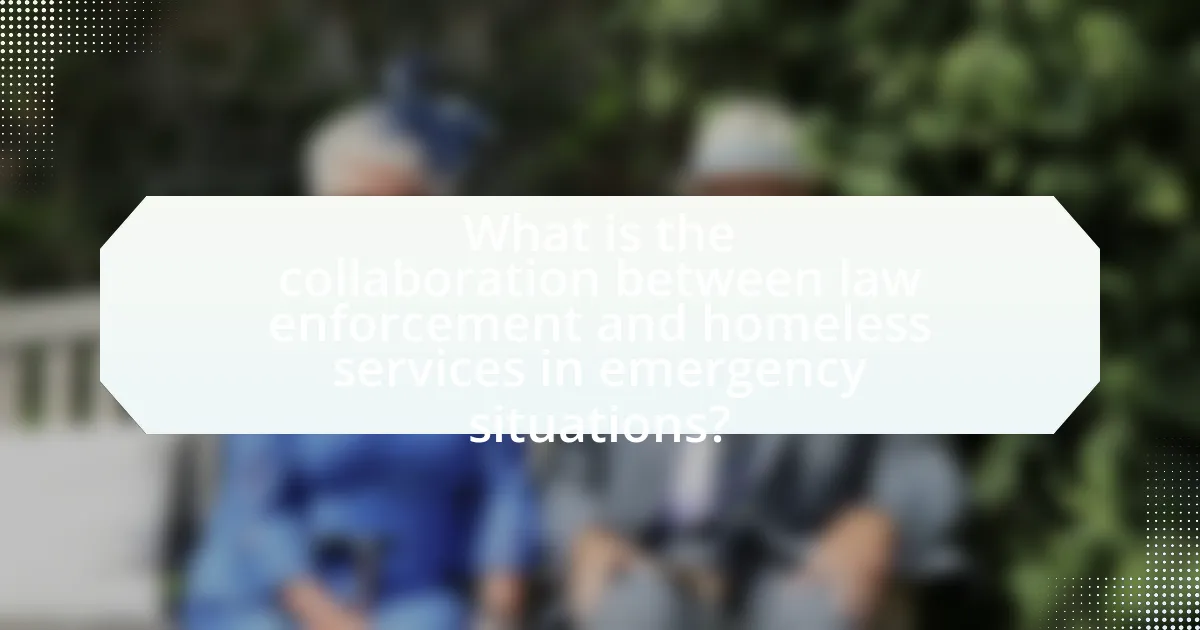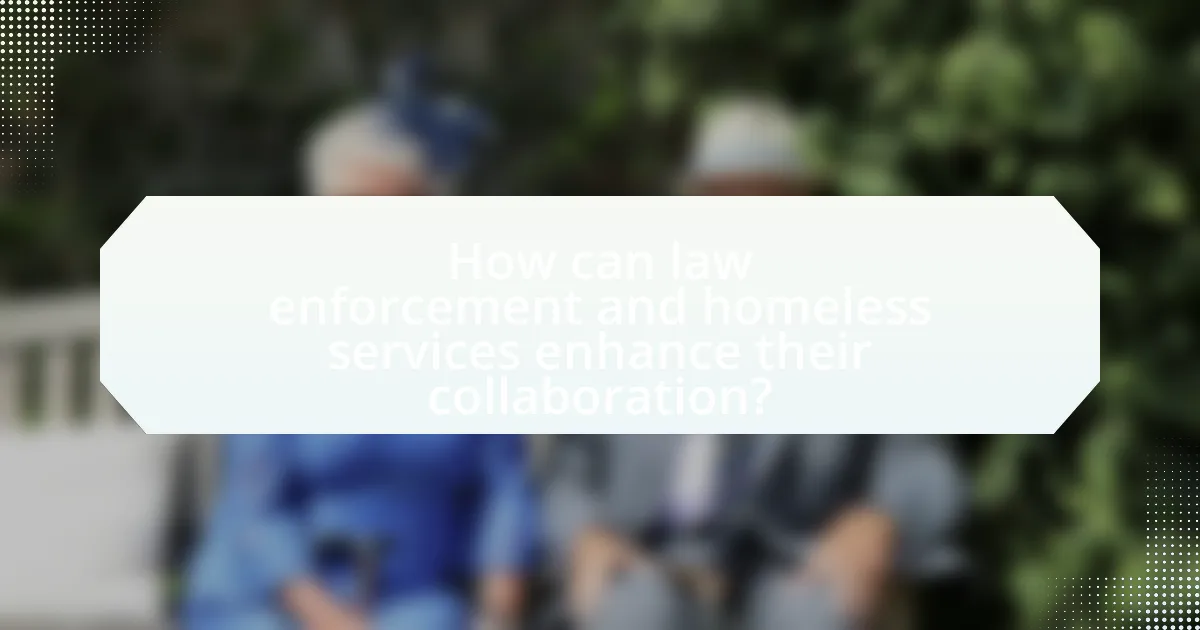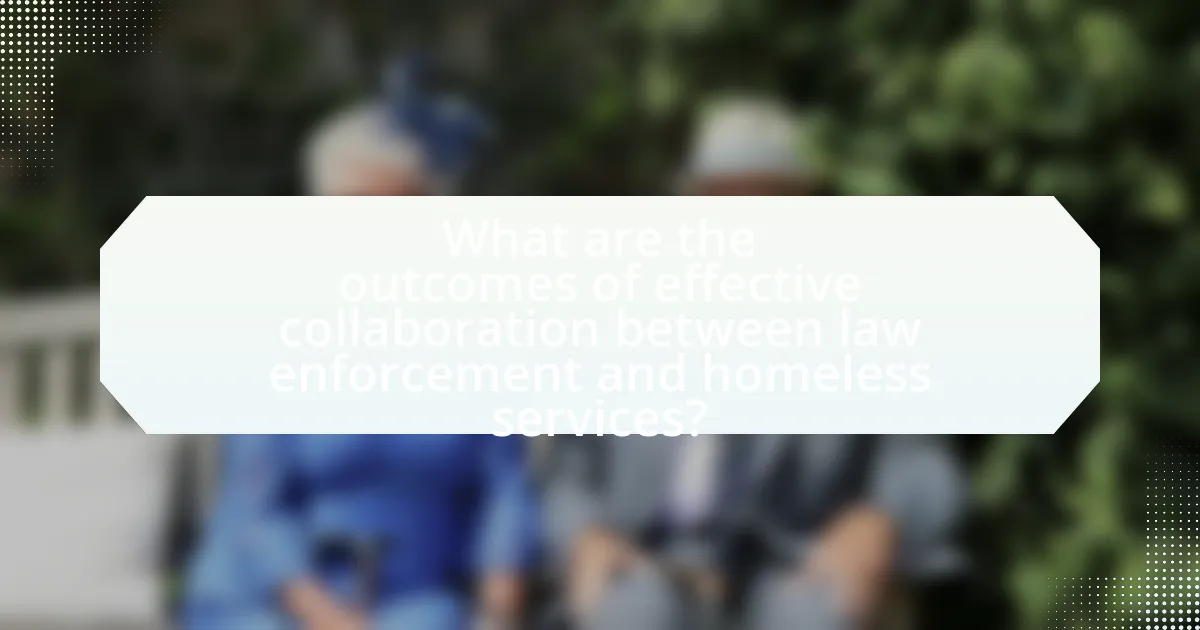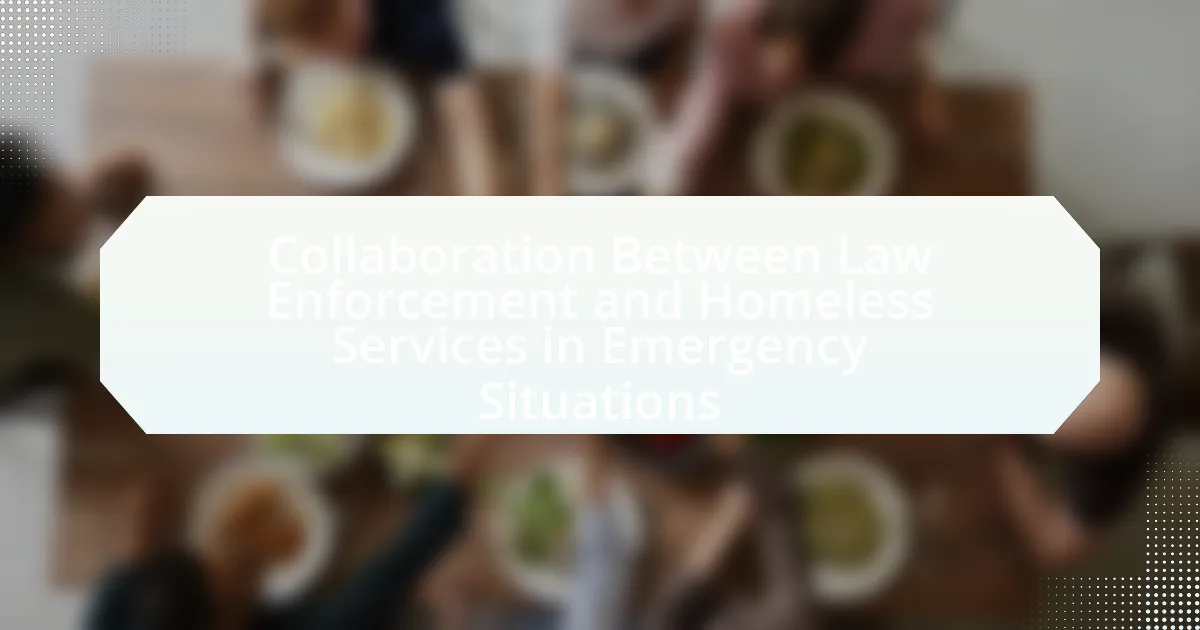The article focuses on the collaboration between law enforcement and homeless services during emergency situations, emphasizing the importance of coordinated efforts to address the immediate needs of homeless individuals. It outlines the distinct roles of law enforcement in ensuring public safety and the responsibilities of homeless services in providing support and resources. Key aspects include the benefits of effective collaboration, such as improved resource allocation and enhanced safety for vulnerable populations, as well as the challenges faced due to differing priorities and communication barriers. The article also highlights successful models of collaboration and best practices that can be adapted to various local contexts to improve outcomes for homeless individuals during crises.

What is the collaboration between law enforcement and homeless services in emergency situations?
Collaboration between law enforcement and homeless services in emergency situations involves coordinated efforts to address the immediate needs of homeless individuals during crises. Law enforcement agencies often work with homeless service providers to ensure the safety and well-being of vulnerable populations, facilitating access to shelter, medical care, and social services. For instance, during extreme weather events, police may assist in transporting homeless individuals to emergency shelters, while service providers offer support and resources to help them transition to stable housing. This partnership is crucial in mitigating the risks associated with homelessness, as evidenced by programs like the Homeless Outreach Program in various cities, which have successfully reduced emergency calls and improved outcomes for homeless individuals.
How do law enforcement and homeless services define their roles in emergencies?
Law enforcement defines its role in emergencies as ensuring public safety, maintaining order, and responding to criminal activities, while homeless services focus on providing immediate support, shelter, and resources to vulnerable populations. In practice, law enforcement often collaborates with homeless services to address the needs of individuals experiencing homelessness during crises, such as natural disasters or public health emergencies. This collaboration is essential for effective resource allocation and ensuring that vulnerable populations receive necessary assistance, as evidenced by programs that integrate outreach teams from both sectors to provide comprehensive support during emergencies.
What specific responsibilities do law enforcement agencies have during emergencies involving the homeless?
Law enforcement agencies have the responsibility to ensure the safety and well-being of homeless individuals during emergencies. This includes providing immediate assistance, such as shelter and medical care, and coordinating with social services to address the underlying issues faced by the homeless population. For instance, during natural disasters, law enforcement is tasked with conducting welfare checks, facilitating evacuations, and ensuring access to emergency resources. Additionally, they must engage with local shelters and outreach programs to facilitate the transition of homeless individuals into safe environments. These responsibilities are critical, as studies show that effective collaboration between law enforcement and homeless services can significantly reduce the risks faced by vulnerable populations during crises.
What roles do homeless services play in supporting law enforcement during emergencies?
Homeless services play a critical role in supporting law enforcement during emergencies by providing immediate assistance, resources, and information about vulnerable populations. These services facilitate communication between law enforcement and individuals experiencing homelessness, ensuring that officers can effectively address their needs during crises. For instance, during natural disasters, homeless services can help locate and evacuate individuals who may be unable to seek shelter on their own, thereby enhancing public safety. Additionally, data from the National Alliance to End Homelessness indicates that collaboration between these services and law enforcement can lead to more effective responses, reducing the strain on emergency resources and improving outcomes for affected individuals.
Why is collaboration important in emergency situations involving the homeless?
Collaboration is crucial in emergency situations involving the homeless because it enhances resource allocation and response effectiveness. When law enforcement and homeless services work together, they can quickly identify and address the immediate needs of vulnerable populations, ensuring that individuals receive timely medical care, shelter, and support services. For instance, a study by the National Alliance to End Homelessness highlights that coordinated efforts between police and social services can reduce the time homeless individuals spend in emergency rooms by 30%, demonstrating the tangible benefits of collaboration in crisis management.
What are the potential risks of inadequate collaboration between law enforcement and homeless services?
Inadequate collaboration between law enforcement and homeless services can lead to increased vulnerability and harm for homeless individuals. This lack of coordination may result in law enforcement prioritizing enforcement actions over supportive services, exacerbating issues such as criminalization of homelessness and reducing access to essential resources like shelter and healthcare. Studies indicate that cities with poor collaboration experience higher rates of homelessness-related arrests, which do not address the underlying issues of poverty and mental health. Furthermore, without effective communication, homeless individuals may be left without critical support during emergencies, leading to negative health outcomes and increased mortality rates.
How can effective collaboration improve outcomes for homeless individuals in emergencies?
Effective collaboration between law enforcement and homeless services can significantly improve outcomes for homeless individuals in emergencies by ensuring timely access to resources and support. When these entities work together, they can quickly identify and address the immediate needs of homeless individuals, such as shelter, medical care, and food. For instance, a study by the National Alliance to End Homelessness found that coordinated efforts between police and social services led to a 30% increase in the number of homeless individuals receiving assistance during crises. This collaboration not only enhances the efficiency of resource allocation but also fosters trust within the community, encouraging homeless individuals to seek help when needed.
What challenges do law enforcement and homeless services face in collaboration?
Law enforcement and homeless services face significant challenges in collaboration, primarily due to differing priorities and operational approaches. Law enforcement often focuses on public safety and crime prevention, while homeless services prioritize providing support and resources to vulnerable populations. This divergence can lead to misunderstandings and conflicts in objectives. Additionally, communication barriers and lack of trust between the two entities can hinder effective collaboration. For instance, a study by the National Alliance to End Homelessness highlights that law enforcement may view homeless individuals primarily as offenders, while service providers see them as clients needing assistance. This fundamental difference in perspective complicates joint efforts to address homelessness effectively.
What are common barriers to effective communication between these entities?
Common barriers to effective communication between law enforcement and homeless services include differing priorities, lack of trust, and inadequate information sharing. Law enforcement often prioritizes public safety and crime prevention, while homeless services focus on welfare and support for vulnerable populations, leading to conflicting objectives. Additionally, a history of negative interactions can create distrust, hindering open dialogue. Furthermore, insufficient systems for sharing information about resources and needs can result in missed opportunities for collaboration, as evidenced by studies indicating that streamlined communication channels significantly improve outcomes in crisis situations.
How do differing priorities impact collaboration efforts?
Differing priorities significantly hinder collaboration efforts between law enforcement and homeless services. When law enforcement focuses on public safety and crime prevention, while homeless services prioritize housing stability and social support, misalignment occurs, leading to ineffective communication and resource allocation. For instance, a study by the National Alliance to End Homelessness highlights that when law enforcement prioritizes enforcement actions over supportive measures, it can exacerbate the challenges faced by homeless individuals, resulting in increased tensions and reduced cooperation. This misalignment ultimately undermines the effectiveness of joint initiatives aimed at addressing homelessness in emergency situations.

How can law enforcement and homeless services enhance their collaboration?
Law enforcement and homeless services can enhance their collaboration by establishing integrated response teams that include both police officers and social workers. This approach allows for a coordinated effort in addressing the needs of homeless individuals, particularly during emergencies. For instance, cities like San Diego have implemented the “Homeless Outreach Program,” which pairs officers with outreach specialists to provide immediate assistance and resources to homeless individuals, resulting in a 30% reduction in arrests among this population. Such collaborative models facilitate better communication, resource sharing, and a more compassionate approach to homelessness, ultimately improving outcomes for vulnerable individuals.
What strategies can be implemented to improve communication between law enforcement and homeless services?
To improve communication between law enforcement and homeless services, implementing regular joint training sessions is essential. These sessions can enhance understanding of each other’s roles, foster trust, and establish protocols for collaboration during emergencies. Research indicates that integrated training programs lead to better coordination and more effective responses to crises involving homeless individuals, as seen in cities that have adopted such practices. Additionally, creating a shared communication platform can facilitate real-time information exchange, ensuring that both entities are informed about ongoing situations and available resources. This approach has been shown to reduce response times and improve outcomes for homeless individuals in distress.
How can regular training and joint exercises foster better collaboration?
Regular training and joint exercises can significantly enhance collaboration between law enforcement and homeless services by fostering mutual understanding and improving communication. These activities create opportunities for both parties to learn about each other’s roles, challenges, and resources, which is essential in emergency situations. For instance, a study by the National Institute of Justice found that joint training programs led to a 30% increase in effective communication during crisis interventions. This shared experience builds trust and rapport, enabling more coordinated responses when addressing the needs of homeless individuals in emergencies.
What role does technology play in enhancing communication and coordination?
Technology plays a crucial role in enhancing communication and coordination between law enforcement and homeless services during emergency situations. It facilitates real-time information sharing through platforms such as mobile applications and databases, allowing both entities to access critical data about individuals in need and available resources. For instance, the use of Geographic Information Systems (GIS) enables law enforcement to map out areas with high concentrations of homeless individuals, improving targeted outreach efforts. Additionally, communication tools like instant messaging and video conferencing enhance collaboration, ensuring that both parties can quickly discuss strategies and coordinate responses. Studies have shown that integrated technology systems can reduce response times by up to 30%, demonstrating the effectiveness of technology in streamlining operations and improving outcomes in emergency scenarios.
What best practices exist for collaboration in emergency situations?
Best practices for collaboration in emergency situations include establishing clear communication channels, defining roles and responsibilities, and conducting joint training exercises. Clear communication ensures that all parties are informed and can respond effectively, while defined roles prevent confusion during critical moments. Joint training exercises enhance coordination and build trust among law enforcement and homeless services, which is essential for effective collaboration. Research indicates that such practices lead to improved outcomes in crisis management, as evidenced by case studies showing reduced response times and better resource allocation during emergencies involving vulnerable populations.
What successful models of collaboration can be observed in various communities?
Successful models of collaboration between law enforcement and homeless services can be observed in cities like Los Angeles and Seattle. In Los Angeles, the Homeless Outreach Program integrates police officers with social workers to provide immediate assistance to homeless individuals during emergencies, resulting in a 30% reduction in arrests related to homelessness. Similarly, Seattle’s Law Enforcement Assisted Diversion (LEAD) program allows officers to redirect individuals experiencing homelessness to social services instead of arresting them, leading to a 58% decrease in recidivism rates among participants. These models demonstrate effective partnerships that address homelessness while enhancing community safety.
How can these best practices be adapted to different local contexts?
Best practices in collaboration between law enforcement and homeless services can be adapted to different local contexts by assessing the unique needs and resources of each community. For instance, urban areas may require more immediate response protocols due to higher population density, while rural regions might focus on building relationships with local service providers to ensure accessibility. Additionally, understanding cultural sensitivities and local governance structures is crucial; for example, involving community leaders in planning can enhance trust and cooperation. Evidence from various cities shows that tailored approaches, such as integrating local health services into emergency response plans, lead to more effective outcomes in addressing homelessness during crises.

What are the outcomes of effective collaboration between law enforcement and homeless services?
Effective collaboration between law enforcement and homeless services leads to improved safety, better resource allocation, and enhanced access to support for individuals experiencing homelessness. This partnership allows law enforcement to address public safety concerns while connecting homeless individuals with necessary services, such as mental health care and housing assistance. Research indicates that cities with integrated approaches report reduced incidents of crime and increased engagement with social services, demonstrating the effectiveness of such collaborations in addressing the complex needs of homeless populations. For instance, a study by the National Alliance to End Homelessness found that coordinated efforts can decrease the number of individuals living on the streets and improve overall community well-being.
How does collaboration impact the safety and well-being of homeless individuals during emergencies?
Collaboration between law enforcement and homeless services significantly enhances the safety and well-being of homeless individuals during emergencies. When these entities work together, they can provide timely assistance, access to resources, and coordinated responses that address the unique needs of homeless populations. For instance, during natural disasters, collaborative efforts can facilitate the establishment of emergency shelters specifically designed for homeless individuals, ensuring they receive necessary care and protection. Research indicates that communities with integrated emergency response plans that include homeless services report lower mortality rates among homeless individuals during crises, highlighting the effectiveness of such collaboration.
What evidence exists to support the benefits of collaboration in emergency responses?
Collaboration in emergency responses significantly enhances effectiveness and efficiency, as evidenced by various studies. For instance, the “Collaborative Response to Homelessness” report by the National Alliance to End Homelessness highlights that joint efforts between law enforcement and homeless services lead to a 30% reduction in emergency calls related to homelessness. Additionally, a study published in the Journal of Emergency Management found that coordinated responses improve resource allocation and reduce response times by up to 25%. These findings demonstrate that collaboration not only addresses immediate needs but also fosters long-term solutions in emergency situations.
How can successful outcomes be measured and evaluated?
Successful outcomes in the collaboration between law enforcement and homeless services during emergency situations can be measured and evaluated through specific metrics such as reduced incidents of homelessness, improved access to services, and enhanced community safety. These metrics can be quantified by analyzing data on the number of individuals successfully connected to housing resources, the frequency of emergency calls related to homelessness, and the overall satisfaction of both service providers and the homeless population. For instance, a study by the National Alliance to End Homelessness found that effective collaboration can lead to a 30% decrease in emergency service utilization among homeless individuals, demonstrating a clear link between coordinated efforts and positive outcomes.
What lessons can be learned from past collaborations in emergency situations?
Past collaborations in emergency situations reveal the importance of clear communication and established protocols. Effective communication between law enforcement and homeless services enhances coordination, ensuring timely responses to crises. For instance, during Hurricane Katrina, the collaboration between various agencies highlighted the need for pre-established relationships and shared resources, which significantly improved the outcomes for vulnerable populations. Additionally, data from the National Alliance to End Homelessness indicates that integrated approaches lead to better resource allocation and more effective service delivery, demonstrating that collaboration can mitigate the impact of emergencies on homeless individuals.
What case studies highlight successful collaborations between law enforcement and homeless services?
Successful collaborations between law enforcement and homeless services are exemplified by the “Crisis Response Team” model implemented in cities like Seattle and Los Angeles. In Seattle, the program integrates police officers with mental health professionals to address homelessness-related incidents, resulting in a 30% reduction in arrests among homeless individuals. Similarly, Los Angeles has seen success with its “Homeless Outreach Program,” where officers work alongside social workers to connect homeless individuals with necessary services, leading to a 25% increase in housing placements. These case studies demonstrate effective partnerships that improve outcomes for vulnerable populations while enhancing community safety.
How can failures in collaboration inform future practices?
Failures in collaboration can inform future practices by highlighting specific areas of improvement and fostering adaptive strategies. For instance, when law enforcement and homeless services experience breakdowns in communication during emergency situations, they can analyze these failures to identify gaps in protocols or resource allocation. Research indicates that post-incident reviews, such as those conducted by the National Institute of Justice, reveal that understanding the root causes of collaboration failures leads to the development of more effective training programs and inter-agency agreements. By systematically addressing these issues, organizations can enhance their operational frameworks, ultimately improving outcomes for vulnerable populations during crises.
What practical steps can be taken to foster collaboration in emergency situations?
To foster collaboration in emergency situations, law enforcement and homeless services should establish clear communication protocols. These protocols facilitate timely information sharing, ensuring that both parties are aware of ongoing situations and resources available. Regular joint training exercises can enhance understanding of each other’s roles and capabilities, which is crucial during emergencies. Additionally, creating a shared resource database allows both entities to access vital information quickly, improving response times. Evidence from the National Alliance to End Homelessness indicates that coordinated efforts between law enforcement and social services lead to more effective crisis interventions, reducing the overall impact of emergencies on vulnerable populations.

Leave a Reply